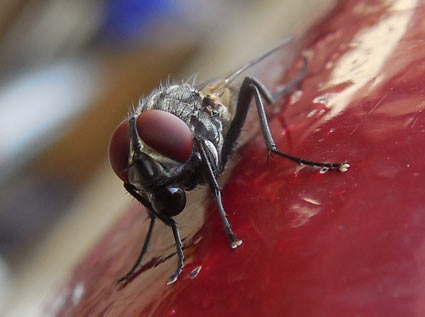Fatal Attraction
Understanding what attracts house flies is key to control
Filth flies such as house flies, cluster flies, and fruit flies pick up and carry more than 100 pathogens as they feed and breed upon contaminated matter that carries disease-causing organisms. House flies regurgitate digestive fluids and defecate where they feed and rest making them not only a nuisance, but also a threat to public health and food safety. These two concerns also are essential to protecting the bottom line of commercial accounts—especially those in food handling and food service.
Typical house fly life cycles are four to 12 weeks long, undergoing a complete metamorphosis—egg, larva, pupa, and adult—during that time. Females place numerous eggs upon, or adjacent to, appropriate nutritional sources based upon environmental cues. Depending upon conditions, growth to the adult stage requires as little as two days to three weeks. As a result, effective fly treatment requires attention to detail and constant monitoring and management to break this life cycle and cut down population growth.
Adult flies become active immediately post-emergence, seeking animal wastes, garbage and food materials to feed and breed on. Exploitable wastes and sanitation deficits are potent attraction and reproductive sites, meaning that commercial accounts such as restaurants, bakeries, supermarkets and food processing plants—with their wealth of food, waste, dumpsters and drains—are particularly susceptible to fly infestations.
The most effective fly control methods involve an integrated approach. The first, and most critical step for fly treatments is inspection. Inspection allows for the identification of the type of fly that is the primary problem and the sources of the infestation. This step involves working closely with the client to ensure ongoing and effective sanitation, exclusion (closed doors and functioning screens), and drainage practices. Helping clients understand why their location is susceptible to fly problems is crucial for infestation prevention in the future. After inspection, employ product solutions to address problematic areas.
Flies are attracted to moist, cool, shady areas where they can avoid the sun and wind to lay eggs; this is why areas under roofs, dumpsters, large appliances, and drains are where flies congregate. Residual insecticides should be sprayed to prevent flies from landing in these areas. Baits should also be applied in these shaded areas to maximize the kill rate and to help draw the flies away from food handling zones.

Attribution: By Aravind Sivaraj
|
Recent research has concluded that house flies characteristically search and feed on sugar sources just after emergence for their survival. Therefore, sugar-based fly baits, especially those that also include pheromones, provide the perfect strategy for a fatal attraction to draw and kill flies away from other food sources. As with many insects, flies can develop a resistance to frequently used active ingredients. To prevent this, a rotation of fly bait products is recommended to ensure successful fly baiting treatments.
QuikStrike Fly Bait with the active ingredient Dinotefuran, Z-9 tricosene, a large blue bait particle size, and rich sugar-based attractant kills house flies resistant to Pyrethrin and organophosphates. QuikStrike is a judicious fly baiting system for optimum fly control in meat and poultry processing, broiler houses, kennels, livestock barns, sheds, recycling areas, compactor chutes, dumpsters, trash receptacles and more. The exclusive, easy to use Starbar Fly Bait Station allows additional strategic fly bait points of deployment. Use QuikStrike and Golden Malrin Fly Baits as part of a rotation program to prevent resistance.
Golden Malrin Fly Bait controls nuisance flies quickly and effectively. It effectively lures male and female flies with the powerful aggregation pheromone Muscamone and the added visual lure through large blue bait particle size. Flies immediately feed upon the rich sugar-based bait while the active ingredient Methomyl optimally kills flies. For best results, rotate with QuikStrike Fly Bait to reduce resistance and maximize each bait’s killing potential. Use outside of restaurants, kennels, bakeries, supermarkets, dumpsters, and warehouses to treat fly infestations. To know your pest and to know your product, go to http://www.zoecon.com/insects/flies.
Citations:
Musca Domestica (Diptera: Muscidae) and the Transfer of Clostridium Difficile from Proceedings of the Seventh International Conference on Urban Pests.
Combination of Phagostimulant and Visual Lure as an Effective Tool in Designing House Fly Toxic Baits: A Laboratory Evaluation from PLoS ONE.
PMP’s Direct To You provides pest management professionals with educational refreshers on timely and critical topics essential to operational success. This content is not be used as a substitute for obtaining legal advice from an attorney licensed to practice where you live. Look for the content-rich PMP Direct To You archives at mypmp.net/direct-to-you-archive.
|